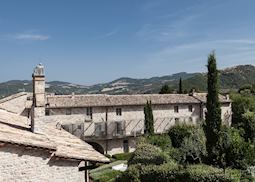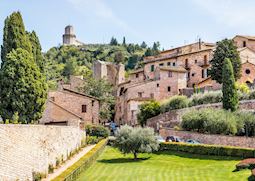Jump to:
Set against a backdrop of wooded hills, the medieval hilltown of Assisi would merit a visit even without its spiritual significance as the birthplace of Saint Francis. It was here that the founder of the Franciscan church was born in 1181, and the Saint Francis Basilica is a place of pilgrimage for Catholics from all over the world. You don’t need to be religious to enjoy a visit however, for the town’s historic core is a UNESCO World Heritage Site, its streets littered with Roman, Romanesque, Gothic and medieval treasures, among them some of the finest artworks in the world.
Things to see and do in Assisi
Saint Francis Basilica
Assisi’s central attraction, the basilica, dominates the historic core, its simple façade lording over the medieval streets. Construction began in 1228 when Pope Gregory IX laid the foundation stone on the day after Francis was sainted. The basilica consists of two churches: the Lower Church, built in heavy Romanesque style, was completed in 1230, while construction of the much lighter, early-Gothic Upper Church began nine years later.
Beyond its position as one of the prime pilgrimage sites in Italy, the basilica houses a significant collection of medieval masterpieces, with the artworks and frescoes inside tracing the development of Italian art in the late medieval period.
The Lower Church
Dimly lit with low vaulting and an extensive collection of religious frescoes, the Lower Church is home to the crypt of Saint Francis. Inside, almost every inch is decorated in an elaborate series of frescoes that span almost a century of work by artists such as Cavallini, Cimabue, Lorenzetti and Martini. Look for Saint Martin’s Chapel, which is richly decorated, and the four allegories in the vaults above the altar that depict the Franciscan virtues of poverty, chastity and obedience. Descending a double stairway, you’ll reach the crypt of Saint Francis, only rediscovered in 1818.
The Upper Church
Consecrated in 1253, the Upper Church is lighter, brighter and even more ornate. Inside, it houses one of the most significant religious artworks in Italy, a series of 28 frescoes attributed to Giotto that depict the life of Saint Francis.
Starting on the wall to the right of the altar and continuing in a clockwise direction, the frescoes include a scene of Francis Preaching to the Birds that is reproduced on publications worldwide. More importantly perhaps, is their long-lasting influence: by reflecting Franciscan virtues and depicting natural rather than supernatural scenes and figures, the frescoes changed the course of religious iconography.
Temple of Minerva and Roman forum
Site of Assisium’s Roman forum, the Piazza del Commune is dominated by the 1st-century BC Temple of Minerva. Although only the façade remains, it’s an imposing reminder of the importance of the town since ancient times. Behind the 2,000-year old columns sits the 16th-century Church of Santa Maria Sopra Minerva, which is decorated in ornate Baroque style.
Below the square, you can enter the excavated remains of the forum, including a cistern, magistrates’ podium, fountain, shops and a small temple, which now all sit 5 m (16 ft) below the current ground level.
Basilica di Santa Chiara
The 13th-century pink-and-white banded Basilica di Santa Chiara is built in Romanesque style with massive flying buttresses. It’s dedicated to Saint Clare, a contemporary of Saint Francis who founded the Order of Poor Ladies, now known as the Order of Saint Clare or the Poor Clares.
Inside, there’s a large rose window and in the crypt, the tomb of Saint Clare along with some of her clothes and hair. You can also see the original Byzantine Cross of San Damiano. It’s said that Saint Francis was praying in front of this cross when he heard the voice of God speaking to him.
Assisi in World War II
Saint Francis’s influence has remained present in the city for centuries. During World War II a local priest, Father Rufino Niccacci, assisted by a sympathetic German commander, Valentin Müller, helped save 300 Jews as well as the city’s treasures.
Together they contrived to have Assisi declared an open city, off limits to attack. Then, with the help of local people, printworks and religious communities, they sheltered refugees, provided false papers and hid Jews in plain sight. The underground group included a former Giro d’Italia and Tour de France winner, Gino Bartali, who couriered forged papers and photographs around the region while in training.
Modern-day Assisi
Assisi is a major visitor hub and at times can become swamped with visitors, the knick-knack stalls and tourist restaurants taking away some of its intrinsic charm. However, stay after the day trippers have left or visit outside of peak season, and its quiet streets and warm, stone houses reveal an entirely different side to the city.
Best time to visit Assisi
A major pilgrimage site, Assisi is busy year-round, but the best times to visit are April to June or September and October when you’ll benefit from warm, dry weather but avoid the crowds of the peak summer months of July and August. Winters are quieter but colder, while religious holidays can be uncomfortably busy.
who's been there
-
01993 838 92501993 838 960
- Make an enquiry
Suggested itinerary featuring Assisi
This sample itinerary will give you an idea of what is possible when you travel in Assisi, and showcases routes we know work particularly well. Treat this as inspiration, because your trip will be created uniquely by one of our specialists.
Places near Assisi
- Umbria 11 miles away
- Perugia 12 miles away
- Orvieto 36 miles away
- Siena 68 miles away
- Rome 82 miles away
- Florence 84 miles away
- San Gimignano 85 miles away
- Ravenna 96 miles away
- Bologna 118 miles away
- Pisa 121 miles away
- Forte dei Marmi 138 miles away
- Modena 139 miles away
- Porto Venere 156 miles away
- Cinque Terre 162 miles away
- Venice 165 miles away
- Parma 166 miles away
- Ischia 176 miles away
- Naples 176 miles away
- Herculaneum 181 miles away
- Verona 183 miles away
- Pompeii 188 miles away
- Portofino and Santa Margherita 191 miles away
- Sorrento 192 miles away
- Capri 193 miles away
- Sirmione 194 miles away
- The Amalfi Coast 198 miles away
- Lake Garda 201 miles away
- Gardone Riviera 204 miles away
- Genoa 206 miles away
- Costa Smeralda 210 miles away
- Dolomites 235 miles away
- Madonna di Campiglio 236 miles away
- Milan 238 miles away
- Alta Badia 246 miles away
- Barbaresco 254 miles away
- Alba 255 miles away
- Barolo 257 miles away
- Como 258 miles away
- Blevio 259 miles away
- Torno 259 miles away
- Laglio 260 miles away
- Lezzeno 261 miles away
- Bellagio 261 miles away
- Lake Como 264 miles away
- Tremezzo 264 miles away
- Matera 264 miles away
- Sardinia 277 miles away
- Piedmont 279 miles away
- Puglia 280 miles away
- Stresa 281 miles away
- Lake Maggiore 281 miles away
- Turin 282 miles away
- Verbania 282 miles away
- Alberobello 286 miles away
- Fasano 289 miles away
Photos of Assisi
Accommodation choices for Assisi
We’ve selected a range of accommodation options for when you visit Assisi. Our choices usually come recommended for their character, facilities and service or location. Our specialists always aim to suggest properties that match your preferences.
Ideas for experiencing Assisi
Our specialists seek out authentic ways to get to know the places that could feature in your trip. These activities reflect some of the experiences they've most enjoyed while visiting Assisi, and which use the best local guides.
-
Assisi walking tour and Spello ![Gardens of St Francis, Assisi]()
Assisi walking tour and Spello
Assisi walking tour and Spello
Get an expert’s view of medieval Assisi on this guided walking tour that introduces you to the highlights of Saint Francis’s hometown as well as the quiet hilltown of Spello where Roman walls encircle a tangle of winding streets.
View details













